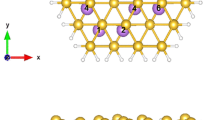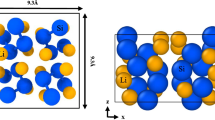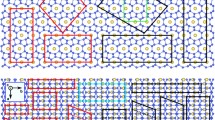Abstract
In this work, we present a theoretical study of the electronic band structure and the Young’s modulus of hydrogen-passivated silicon nanowires (H-SiNWs), grown along the [110] crystallographic direction, as a function of the concentration of interstitial sodium (Na) and lithium (Li) atoms. The study is performed using the supercell scheme and the density functional theory (DFT), within the local density approximation (LDA). The results show that the presence of Na or Li atoms closes the former semiconducting band gap of the H-SiNWs and shifts the Fermi energy into the conduction band. The transition from semiconductor to metal occurs as soon as a single Na or Li atom is added to the nanowire and the number of occupied states near the Fermi level is larger for the H-SiNWs with Li atoms in comparison with those nanowires with the same concentration of Na atoms. The calculated formation energies reveal that the system becomes less stable when the concentration of Na and Li atoms augments. Moreover, the obtained binding energies indicate that Si–Li and Si–Na bonds are formed. It is worth mentioning that the binding energies of H-SiNWs with interstitial Li atoms are larger than those corresponding to the H-SiNWs with interstitial Na atoms. On the other hand, the Young’s moduli of H-SiNWs with Na atoms are lower than those of pure H-SiNWs and their values diminish when the concentration of Na atoms increases. In contrast, Young’s moduli of H-SiNWs present a non-monotonic behavior as a function of the concentration of interstitial Li atoms and for the largest studied concentration the nanowire fractures. These results give insight into the changes that electronic and mechanical properties of H-SiNWs suffer during the charge-discharge process, which should be taken into account in the design of electrodes of Na or Li-ion batteries.









Similar content being viewed by others
References
Priolo F, Gregorkiewicz T, Galli M, Krauss TF (2014) Silicon nanostructures for photonics and photovoltaics. Nat Nanotechnol 9:19–32. https://doi.org/10.1038/nnano.2013.271
Mallorquí AD, Alarcón-Lladó E, Mundet IC et al (2015) Field-effect passivation on silicon nanowire solar cells. Nano Res 8:673–681. https://doi.org/10.1007/s12274-014-0551-7
Share K, Westover A, Li M, Pint CL (2016) Surface engineering of nanomaterials for improved energy storage – A review. Chem Eng Sci 154:3–19. https://doi.org/10.1016/J.CES.2016.05.034
Wei L, Hou Z, Wei H (2017) Porous Sandwiched Graphene/Silicon Anodes for Lithium Storage. Electrochim Acta 229:445–451. https://doi.org/10.1016/j.electacta.2017.01.173
Palacin MR, de Guibert A (2016) Why do batteries fail?. Science 351(6273):1253292. https://doi.org/10.1126/science.1253292
Nagelberg AS, Worrell WL (1979) A thermodynamic study of sodium-intercalated TaS2 and TiS2. J Solid State Chem 29:345–354. https://doi.org/10.1016/0022-4596(79)90191-9
Mizushima K, Jones PC, Wiseman PJ, Goodenough JB (1980) Lithium cobalt oxide(LixCoO2) (0<x≤1): a new cathode material for batteries of high energy density. Mater Res Bull 15:783–789. https://doi.org/10.1016/0025-5408(80)90012-4
Yabuuchi N, Kubota K, Dahbi M, Komaba S (2014) Research Development on Sodium-ion Batteries. Chem Rev 114:11636–11682. https://doi.org/10.1021/cr500192f
Landi BJ, Ganter MJ, Cress CD et al (2009) Carbon nanotubes for lithium ion batteries. Energy Environ Sci 2:638–654. https://doi.org/10.1039/b904116h
Bruce PG, Scrosati B, Tarascon JM (2008) Nanomaterials for Rechargeable Lithium Batteries. Angew Chemie - Int Ed 47:2930–2946. https://doi.org/10.1002/anie.200702505
McDowell MT, Lee SW, Nix WD, Cui Y (2013) 25th Anniversary Article: Understanding the Lithiation of Silicon and Other Alloying Anodes for Lithiumion Batteries. Adv. Mater. 25:4966–4985. https://doi.org/10.1002/adma.201301795
Su X, Wu Q, Li J et al (2014) Silicon-Based Nanomaterials for Lithium-ion Batteries: A Review. Adv Energy Mater 4:1300882. https://doi.org/10.1002/aenm.201300882
Szczech JR, Jin S (2011) Nanostructured silicon for high capacity lithium battery anodes. Energy Environ Sci 4:56–72. https://doi.org/10.1039/c0ee00281j
Chan CK, Peng H, Liu G et al (2008) High-performance lithium battery anodes using silicon nanowires. Nat Nanotechnol 3:31–35. https://doi.org/10.1038/nnano.2007.411
Wan W, Zhang Q, Cui Y, Wang E (2010) First principles study of lithium insertion in bulk silicon. J Phys Condens Matter 22:415501. https://doi.org/10.1088/0953-8984/22/41/415501
Zhang Q, Zhang W, Wan W et al (2010) Lithium Insertion In Silicon Nanowires: An ab Initio Study. Nano Lett 10:3243–3249. https://doi.org/10.1021/nl904132v
Chou CY, Lee M, Hwang GS (2015) A Comparative First-Principles Study on Sodiation of Silicon, Germanium, and Tin for Sodium-ion Batteries. J Phys Chem C 119:14843–14850. https://doi.org/10.1021/acs.jpcc.5b01099
Song T, Hu L, Paik U (2014) One-Dimensional Silicon Nanostructures for Li Ion Batteries. J Phys Chem Lett 5:720–731. https://doi.org/10.1021/jz4027979
McDowell MT, Lee SW, Ryu I et al (2011) Novel Size and Surface Oxide Effects in Silicon Nanowires as Lithium Battery Anodes. Nano Lett 11:4018–4025. https://doi.org/10.1021/nl202630n
Liu Y, Fan LZ, Jiao L (2017) Graphene highly scattered in porous carbon nanofibers: a binder-free and high-performance anode for sodium-ion batteries. J Mater Chem A 5:1698–1705. https://doi.org/10.1039/c6ta09961k
Palomares V, Serras P, Villaluenga I et al (2012) Na-ion batteries, recent advances and present challenges to become low cost energy storage systems. Energy Environ Sci 5:5884–5901. https://doi.org/10.1039/c2ee02781j
Liu Y, Zhang N, Kang H et al (2015) WS 2 Nanowires as a High-Performance Anode for Sodium-Ion Batteries. Chem - A Eur J 21:11878–11884. https://doi.org/10.1002/chem.201501759
Ong SP, Chevrier VL, Hautier G et al (2011) Voltage, stability and diffusion barrier differences between sodium-ion and lithium-ion intercalation materials. Energy Environ Sci 4:3680–3688. https://doi.org/10.1039/c1ee01782a
Ansari R, Shahnazari A, Malakpour S et al (2016) A DFT study on the elastic and plastic properties of MoS 2 nanosheet subjected to external electric field. Superlattices Microstruct 97:506–518. https://doi.org/10.1016/j.spmi.2016.07.014
Ansari R, Ajori S, Malakpour S (2016) Prediction of structural and mechanical properties of atom-decorated porous graphene via density functional calculations. Eur Phys J Appl Phys 74:10401. https://doi.org/10.1051/epjap/2016150405
Kennedy T, Brandon M, Ryan KM (2016) Advances in the application of silicon and germanium nanowires for high-performance lithium-ion batteries. Adv Mater 28:5696–5704. https://doi.org/10.1002/adma.201503978
McDowell MT, Xia S, Zhu T (2016) The mechanics of large-volume-change transformations in high-capacity battery materials. Extrem Mech Lett 9:480–494. https://doi.org/10.1016/j.eml.2016.03.004
Tang D-M, Ren C-L, Wang M-S et al (2012) Mechanical properties of Si nanowires as revealed by in situ transmission electron microscopy and molecular dynamics simulations. Nano Lett 12:1898–1904. https://doi.org/10.1021/nl204282y
Ceperley DM, Alder BJ (1980) Ground State of the Electron Gas by a Stochastic Method. Phys Rev Lett 45:566–569. https://doi.org/10.1103/PhysRevLett.45.566
Perdew JP, Zunger A (1981) Self-interaction correction to density-functional approximations for many-electron systems. Phys Rev B 23:5048–5079. https://doi.org/10.1103/PhysRevB.23.5048
Soler JM, Artacho E, Gale JD et al (2002) The SIESTA method for ab initio order-N materials simulation. J Phys Condens Matter 14:2745–2779. https://doi.org/10.1088/0953-8984/14/11/302
Kleinman L, Bylander DM (1982) Efficacious Form for Model Pseudopotentials. Phys Rev Lett 48:1425–1428. https://doi.org/10.1103/PhysRevLett.48.1425
Monkhorst HJ, Pack JD (1976) Special points for Brillouin-zone integrations. Phys Rev B 13:5188. https://doi.org/10.1103/PhysRevB.13.5188
Wei S, Allan DC, Wilkins JW (1992) Elastic constants of a Si/Ge superlattice and of bulk Si and Ge. Phys Rev B 46:12411–12420. https://doi.org/10.1103/PhysRevB.46.12411
Artacho E, Sánchez-Portal D, Ordejón P et al (1999) Linear-Scaling ab-initio Calculations for Large and Complex Systems. Phys Status Solidi 215:809–817. https://doi.org/10.1002/(SICI)1521-3951(199909)215:1<809::AID-PSSB809>3.0.CO;2-0
Junquera J, Paz Ó, Sánchez-Portal D, Artacho E (2001) Numerical atomic orbitals for linear-scaling calculations. Phys Rev B - Condens Matter Mater Phys 64:1–9. https://doi.org/10.1103/PhysRevB.64.235111
Kittel C (1996) Introduction to Solid State Physics, 7 th. John Wiley & sons, New York
Kulish VV, Malyi OI, Ng MF et al (2014) Controlling Na diffusion by rational design of Si-based layered architectures. Phys Chem Chem Phys 16:4260–4267. https://doi.org/10.1039/c3cp54320j
González I, Sosa AN, Trejo A et al (2018) Lithium effect on the electronic properties of porous silicon for energy storage applications: a DFT study. Dalt Trans 47:7505–7514. https://doi.org/10.1039/c8dt00355f
González-Macías A, Salazar F, Miranda A et al (2018) Theoretical study of the mechanical and electronic properties of [111]-Si nanowires with interstitial lithium. J Mater Sci Mater Electron 29:15795–15800. https://doi.org/10.1007/s10854-018-9331-6
Amato M, Ossicini S, Rurali R (2011) Band-Offset Driven Efficiency of the Doping of SiGe Core-Shell Nanowires. Nano Lett 11:594–598. https://doi.org/10.1021/nl103621s
Arrieta U, Katcho NA, Arcelus O, Carrasco J (2017) First-Principles Study of Sodium Intercalation in Crystalline NaxSi24(0 ≤ x ≤ 4) as Anode Material for Na-ion Batteries. Sci Rep 7:1–8. https://doi.org/10.1038/s41598-017-05629-x
González-Macías A, Salazar F, Miranda A et al (2018) Lithium effects on the mechanical and electronic properties of germanium nanowires. Nanotechnology 29:154004. https://doi.org/10.1088/1361-6528/aaaad4
Salazar F, Pérez LA (2012) Theoretical study of electronic and mechanical properties of GeC nanowires. Comput Mater Sci 63:47–51. https://doi.org/10.1016/j.commatsci.2012.05.066
Lee B, Rudd RE (2007) First-principles calculation of mechanical properties of Si<001> nanowires and comparison to nanomechanical theory. Phys Rev B 75:195328. https://doi.org/10.1103/PhysRevB.75.195328
Zhang WW, Huang QA, Yu H, Lu LB (2009) Size-Dependent Elasticity of Silicon Nanowires. Adv Mater Res 60–61:315–319. https://doi.org/10.4028/www.scientific.net/AMR.60-61.315
Wortman JJ, Evans R a. (1965) Young’s Modulus, Shear Modulus, and Poisson’s Ratio in Silicon and Germanium. J Appl Phys 36:153–156. https://doi.org/10.1063/1.1713863
Funding
This work was supported by SIP-IPN multidisciplinary projects 2018-1969, -1937, -1239, and -1293; and UNAM-PAPIIT IN109320. Computations were done at supercomputer Miztli of DGTIC-UNAM (project LANCAD-UNAM-DGTIC-180), and ABACUS of CINVESTAV.
Author information
Authors and Affiliations
Corresponding author
Additional information
Publisher’s note
Springer Nature remains neutral with regard to jurisdictional claims in published maps and institutional affiliations.
This paper belongs to Topical Collection QUITEL 2018 (44th Congress of Theoretical Chemists of Latin Expression)
Rights and permissions
About this article
Cite this article
Salazar, F., Trejo-Baños, A., Miranda, A. et al. Interstitial sodium and lithium doping effects on the electronic and mechanical properties of silicon nanowires: a DFT study. J Mol Model 25, 338 (2019). https://doi.org/10.1007/s00894-019-4239-5
Received:
Accepted:
Published:
DOI: https://doi.org/10.1007/s00894-019-4239-5




